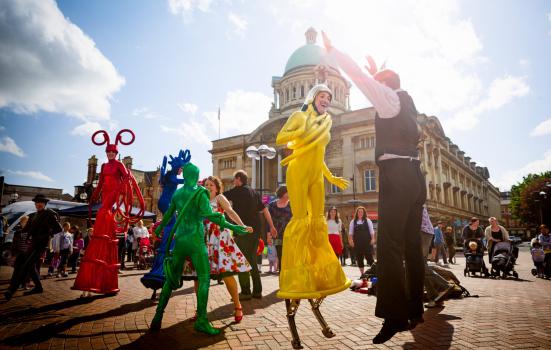With a fundraising target of £18m for Hull 2017, James Trowsdale knows how to present a project application that stands out from the competition. He shares his tips.

At the delivery company for Hull 2017, we are preparing the next major event in the nation’s cultural calendar. As only the second city in the UK to hold the title of ‘UK City of Culture’, we know that the eyes of the world will be upon us as we deliver this world-class, creative and ambitious programme of events. To help the company achieve its creative vision, we have a fundraising target of at least £18m. On winning the title, which was awarded in 2013, we had limited public funding of £3.5m from Hull City Council and £3m from Arts Council England (ACE).
One of my key tasks is to develop partnerships with trusts, foundations, the Lottery and other public sector organisations. To date, the fellow principal partners are the BBC, the University of Hull, East Riding of Yorkshire Council and Yorkshire Water, with the British Council, BP and Spirit of 2012 as major partners.
Facts and figures are vital and all assertions need to be reinforced with evidence
As anyone who works or volunteers in the arts sector will know, the funding climate is becoming increasingly tough. It is great news for the sector as a whole that the government has announced an increase in ACE’s budget and that there is still support for Lottery-funded programmes, but continued pressure on local authority budgets could see historic agreements facing increasing pressure. One obvious impact of public sector cuts is to look to trusts and foundations for funding. But applying for funding is tougher than ever, thanks to a challenging investment market and increased competition. Any appraiser of funding applications will be trained to ask “So what?” or “What difference will this project make to my trust’s strategic objectives?” Therefore it is vital that any application stands out from the field.
The first issue to consider before making any application is to define the opportunity you wish to activate. This thought process should take place before outlining what the project is. Funders want to know the need for the project and this should be explained clearly, without jargon and assuming no local knowledge. Spell out your audience, your reach and don’t forget to include basic information that you may consider obvious about what you do, and why and where you do it.
Facts and figures are vital and all assertions need to be reinforced with evidence. Ideally this should be primary research which shows a clear need for your project and links to your overall strategic direction. Encourage staff, volunteers and trustees to take a step back and think about why they are doing what they are doing.
Once you have taken this step, see what funding is available and find out which funders support projects similar to yours. There are a few search tools for doing this (the ACE website offers a good starting point). Each trust has a different focus. For example, trusts such as the Wolfson Foundation exclusively fund capital projects, while others like the Paul Hamlyn Foundation have a keen interest in advocacy, evaluation and migration. The Esmee Fairburn Foundation is keen to support organisations at a pivotal point, the development of emerging talent and using the arts as an instrument for social change. The Jerwood Charitable Foundation has a particular focus on supporting emerging talent and excellence. The Forward Foundation focuses on poetry and Sainsbury’s Family Charitable Trusts each have a different focus. Whatever your focus, it is also worth thinking outside the box and reconsidering the outcomes for your project. For example, if you are planning to deliver contemporary dance, broaden your search from the trusts interested solely in artistic outcomes to funders interested in health, engagement with hard-to-reach groups, regeneration or education.
Once you know why you want to deliver your project and feel you can explain its impact and describe what it is, it’s time to make the sums add up. From my experience assessing multi-million-pound projects in previous roles, it is remarkable how many funding applications fail on this basic task. Funding in should equal funding out. Tables should add up correctly. And, if quotes are needed as evidence, they must match what it says in the application form. This sounds obvious, but details are all too often overlooked in the dash to complete an application. Last-minute rushes do not help you to present the best case, so give yourself and others time to check the maths, the language and make sure you avoid jargon and the use of acronyms.
All funders are ultimately assessing risk. Are you going to deliver on time and on budget, and are you going to enhance people’s lives? With this in mind, think about how much you ask for. If you turn over £200,000 a year, don’t ask for a grant of £500,000. Also don’t ask for a disproportionate amount of funding from one funder, as many often want to be a minority funder for a project. This means more fundraising from multiple sources, but depending on the nature of the organisation local fundraising can go a long way to show you mean business and that hearts and wallets are in the right place. It’s not the amount of funding raised which is critical in these instances, but showing that the effort has been made.
Working in partnership is a vital characteristic of most successful applications but don’t create a partnership for its own sake – they must be two-way, with shared objectives, mind-sets and methodologies.
Times are challenging and competition is tough, but trusts and foundations want to support great projects which deliver their objectives, so take time to take a step back, think about what you what to do and why, put yourself in the funder’s shoes and don’t give them any reasons to say no.
James Trowsdale is Head of Public Partnerships at Hull UK City of Culture 2017.
www.hull2017.co.uk




